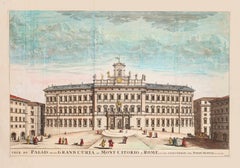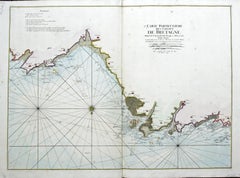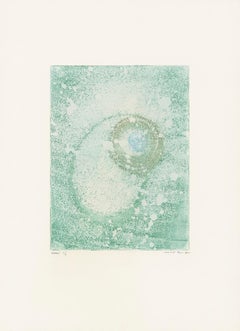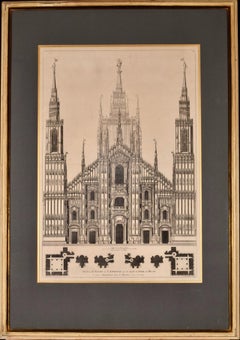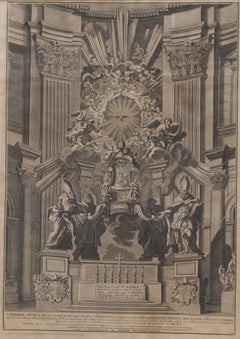Pierre Mortier Art
Dutch, 1661-1711
Pierre Mortier, also referred to as Pieter Mortier, was a Dutch designer. He was known for his activity as a bird's eye map illustrator.
to
2
1
3
1
2
Overall Height
to
Overall Width
to
1
1
1
1
1
1
3
3
6,886
3,210
2,514
1,217
2
1
Artist: Pierre Mortier
Grande Curia Palace - Original Etching by Pierre Mortier - 17th Century
By Pierre Mortier
Located in Roma, IT
Grande Curia Palace is an original hand-colored print realized by the Dutch artist Pierre Mortier in the second half of the XVII century.
Original etching on paper.
Signed on the p...
Category
17th Century Pierre Mortier Art
Materials
Etching
Carte Particular Des Costes De Bretagne Depuis le Cap de Frehel, Jusques a Perros
By Pierre Mortier
Located in Paonia, CO
Carte Particulaire Des Costes De Bretagne Depuis Le Cap de Frehel, Jusques a Perros, & L’Isle Tome. This large sea scale chart shows part of the northwestern co...
Category
1690s Pierre Mortier Art
Materials
Engraving
Carte Particuliere Des Coste De Bretagne qui Comprend Morlaix
By Pierre Mortier
Located in Paonia, CO
Carte Particuliere Des Costes De Bretagne qui Comprend Morlaix, Saint Paul de Leon, les Sept Isles, et L’Isle. Faite par ordre Exprez Du Roy de France is from the collection of ch...
Category
1690s Pierre Mortier Art
Materials
Engraving
Related Items
"Terre des nébuleuses" by Max Ernst, Blue, Fog, Surrealism
By Max Ernst
Located in Köln, DE
Etching and aquatint in colours (colour variation) by Max Ernst.
"Terre des nébuleuses", 1965
38 x 27,5 cm
Copy essai 1/1
Category
1960s Surrealist Pierre Mortier Art
Materials
Etching, Aquatint
Three 19th C. Hand Colored Engravings of London Architecture by T. Shepherd
By Thomas Hosmer Shepherd
Located in Alamo, CA
A set of three hand-colored engravings from "Metropolitan Improvements; or London in the Nineteenth Century", published in London, England in 1828. The scenes were drawn by Thomas Ho...
Category
1820s Realist Pierre Mortier Art
Materials
Engraving
H 12.5 in W 13.75 in D 0.63 in
The Fighting Temeraire: A Framed 19th C. Engraving After J. M. W. Turner
By J.M.W. Turner
Located in Alamo, CA
This beautiful 19th century framed engraving "The Fighting Temeraire" by James Tibbetts Willmore is based on an original painting by the renowned British artist J.M.W. Turner. It was published by James S. Virtue & Co. in London between 1859-1875. It depicts the once mighty British warship the HMS Temeraire being towed away down the river Thames by a much smaller steamboat to a ship-breaking yard to be broken up for scrap. The Temeraire was first launched in 1798 and represented the pinnacle of British ship-building. 180-feet long, constructed of English oak and armed with 98 guns, she was one of the largest warships of the period. The Temeraire became a symbol of British pride and military power that endured throughout the 19th century. The man-of-war served during the French Revolutionary and Napoleonic Wars and was among the last serving ships to have been at the Battle of Trafalgar in 1805. It became one of the many older ships put out of service in the 1830s and 1840s. The once mighty and feared ship symbolizes a once magnificent, but now obsolete, technology. Turner seems to lament her inglorious final journey, being towed by a less magnificent, but modern steam powered tugboat.
The Turner painting was created in 1838 and is now held in the National Gallery in London. Willmore's engraving, created in 1859, captures the dramatic scene with great detail and skill. The image has become an iconic representation of the decline of Britain's naval power and the transition from sail to steam in the 19th century. The sunset in the background is symbolic of the sun going down on British naval power and tradition. The painting conveys profound and diverse themes that are central to the human experience: those of mortality and change, technology and progress, heroism and brutality. The painting demonstrates Turner’s skill as an artist. His ability to produce scenes of great beauty that are dramatic, but are also symbolic, stimulating both thoughtful analysis, as well as emotion. Turner's painting was voted by the British public in a 2005 BBC radio sponsored survey to be the British people's favorite painting of all time. In 2020 it was included on a new British banknote...
Category
Mid-19th Century Romantic Pierre Mortier Art
Materials
Engraving
H 18 in W 20.5 in D 1 in
View of Emden, Germany: A 16th Century Hand-colored Map by Braun & Hogenberg
By Franz Hogenberg
Located in Alamo, CA
This is a 16th century original hand-colored copperplate engraved map of a bird's-eye View of Embden, Germany entitled " Emuda, vulgo Embden vrbs Frisia orientalis primaria" by Georg Braun & Franz Hogenberg, in volume II of their famous city atlas "Civitates Orbis Terrarum", published in Cologne, Germany in 1575.
This is a beautifully colored and detailed map of Emden, a seaport in northwestern Germany, along the Ems River and perhaps portions of over Dollart Bay, near the border with the Netherland. The map depicts a bird's-eye view of the city from the southwest, as well as a view of the harbor and an extensive system of canals. Numerous ships of various sizes, as well as two rowboats containing numerous occupants are seen in the main waterway in the foreground and additional boats line two canals in the center of the city. Two men and two women are shown on a hill in the foreground on the right, dressed in the 16th century style of nobility. Two ornate crests are included in each corner. A title strap-work cartouche is in the upper center with the title in Latin. The crest on the right including Engelke up de Muer (The Little Angel on the Wall) was granted by Emperor Maximilian I in 1495.
This is an English translation of an excerpt of Braun's description of Embden: "In Emden, the capital of East Frisia, rich merchants live in very fine houses. The city has a broad and well-situated harbour, which in my opinion is unique in Holland. Frisia and the whole of the Netherlands, for the ships can anchor here right under the city walls. They have also extended the harbour as far as the New Town, so that up to 400 ships can now find shelter here when the sea is rough."
The emphasis on the harbor and waterways within the city highlights the importance of Emden's place as a seaport at this time. Embden developed from a Dutch/Flemish trading settlement in the 7th-8th centuries into a city as late as late 14th century. In 1494 it was granted staple rights, and in 1536 the harbour was extended. In the mid-16th century Emden's port was thought to have the most ships in Europe. Its population then was about 5,000, rising to 15,000 by the end of the 16th century. The Ems River flowed directly under the city walls, but its course was changed in the 17th century by the construction of a canal. Emden has canals within its city limits, a typical feature of Dutch towns, which also enabled the extension of the harbor. In 1744 Emden was annexed by Prussia and is now part of Germany. It was captured by French forces in 1757 during the Seven Years' War, but recaptured by Anglo-German forces in 1758. During the Napoleonic French era, Emden and the surrounding lands of East Frisia were part of the short-lived Kingdom of Holland.
References:Van der Krogt 4, 1230, State 2; Taschen, Braun and Hogenberg...
Category
16th Century Old Masters Pierre Mortier Art
Materials
Engraving
View of Pisaro, Italy: A 16th Century Hand-colored Map by Braun & Hogenberg
By Franz Hogenberg
Located in Alamo, CA
This is a 16th century original hand-colored copperplate engraved map of View of Pezaro (Pisaro), Italy entitled "Pisaurum vulgo Pezaro" by Georg Braun & Franz Hogenberg, from their famous city atlas "Civitates Orbis Terrarum", published in Augsberg, Germany in 1575.
The map depicts a view of Pesaro, Italy from the west looking over the town to the Adriatic Sea. The River Foglia flows into the Adriatic in the foreground. The only identifiable building is the cathedral of San Domenico, which rises above the other roofs with its tall spire. Two women, dressed in styles of the 16th century are in conversation on a hill in the foreground on the left. Pesaro is in the province of Pesaro and Urbino and lies on the Adriatic and east of Florence. The city, which was founded by the Etruscans and named Pisaurum by the Romans, belonged from AD 754 onwards to the Papal States, and after 1285 was controlled by the princely families of Malatesta, Sforza and della Rovere. Today it is the capital of the province of Pesaro and Urbino and has a population of about 92,000. Pesaro's most famous resident, composer Gioacchino Rossini, was born here in 1792.
The following is an English translation of an excerpt from Braun's description of the city: "We believe that the astonishingly short life of the inhabitants of Pesaro comes not only from the insalubrious air, but also from the great quantity of delectable and delicious fruits which they consume to excess. For this causes the production in their bodies of evil humours, which then lead to incurably fatal diseases. The area around the city is most charming and well planted with vineyards, fig trees, olive trees and other fruit-bearing trees."
References: Van der Krogt 4, 3369, state 1; Taschen, Braun and Hogenberg...
Category
16th Century Old Masters Pierre Mortier Art
Materials
Engraving
The Wedding Procession - Le Cortege nuptial - 17thC Etching from Les Pastorales
By Claudine Bouzonnet-Stella
Located in Meinisberg, CH
Engraved by
Claudine Bouzonnet-Stella
(French, 1636-1697)
After
Jacques Stella (French 1596-1657)
The Wedding Procession - Le Cortege nuptial
• Copper engraving on laid paper
• Sh...
Category
17th Century Naturalistic Pierre Mortier Art
Materials
Laid Paper, Etching, Ink
Free Shipping
H 9.73 in W 12.21 in D 0.4 in
"Bonjour" by Max Ernst, Good Day, Surrealism, Light Colors, Figurative
By Max Ernst
Located in Köln, DE
Etching in colours by Max Ernst.
"Bonjour", 1966
66,5 x 50,1 cm
Copy 7/99
Edition of 111 copies (approx.)
Category
1960s Surrealist Pierre Mortier Art
Materials
Etching, Aquatint
Mayday No. 28, 1989, by Karl Gerich of Bath - Playing Card Proof Print
Located in Meinisberg, CH
Karl Alexander Gerich
(English, 23.4.1956 - 4.1.2016)
Mayday No. 28, 1989
- Etching
- Sheet ca. 37.5 x 26.1 cm
- Plate ca. 32.6 x 23.5 cm
You ask why this pack is called Mayday ? Well, the pack was finished on the 1st of May, 1989 – The day Steven Denis won the World Snooker Championship. Karl was a passionate snooker fan and this is how he marked the victory of his hero, who he also made the joker of this pack.
The proof sheet printed in blue depicts all the court cards, title card, joker & that extra SD joker and the box in which the pack would live.
Sheet is in good condition and suitable to be framed.
Karl was a brilliant playing card maker and certainly one of the most genius artist-craftsmen I had the pleasure to learn about his work and know.
He could do it all: Come up with the tale, weave meaning(s) into it, fill it with spirited characters of his liking, draw it, etch it, print it, colour it and handcraft the inks, paper and card into wondersome packs of playing cards, each of them living in their own, most exquisitely crafted boxes. Every pack a magical marvel, filled with the spirit of this genius card maker … All this he did using his Adana printing press, very simple hand tools and great skill.
When Karl closed down his studio in St.Peter’s Terrace in Bath, England and moved to Poplar Close, he sold off work for which he felt he no longer wanted to be the custodian. So a number of prints reached the market then.
Printed sheets by Karl Gerich...
Category
1980s Naturalistic Pierre Mortier Art
Materials
Paper, Ink, Etching
Free Shipping
H 14.77 in W 10.28 in D 0.04 in
Ulysses Deriding Polyphemus: A Framed 19th C. Engraving After J. M. W. Turner
By J.M.W. Turner
Located in Alamo, CA
This beautiful 19th century framed hand-colored engraving/etching entitled "Ullyses Deriding Polyphemus" by Edward Goodall is based on an original 1829 painting by the renowned Briti...
Category
Mid-19th Century Romantic Pierre Mortier Art
Materials
Engraving, Etching
H 13.88 in W 17.25 in D 1.5 in
St. Michael's Mount, Cornwall: A Framed 19th C. Engraving After Myles Foster
By Myles Birket Foster
Located in Alamo, CA
This beautiful 19th century framed hand-colored engraving is entitled "St. Michael's Mount, Cornwall" by J. Saddler after an original painting by the British artist Myles Birket Fost...
Category
Mid-19th Century Romantic Pierre Mortier Art
Materials
Engraving
H 14.38 in W 17.88 in D 1.5 in
"Triade" by Marino Marini, Lithography, Triad, Figurative Print
By Marino Marini
Located in Köln, DE
Set of 3 etchings and aquatints in colours by Marino Marini
"Triade", 1976-1978
73,7 x 57,5 cm
Copy 4/90
Edition of 125
Marino Marini (Pistoia 1901–1980 Viareggio 1980) - Hardly an...
Category
1970s Modern Pierre Mortier Art
Materials
Etching, Aquatint
"Ludovic Halevy Meeting Madame Cardinal Backstage" after Edgar Degas
By (after) Edgar Degas
Located in Hinsdale, IL
Degas, Edgar (after)
(1834 -1917)
"Ludovic Halevy Meeting Madame Cardinal Backstage"
Soft-Ground Etching created from a Monotype, 1938-9
First State. # 251 from the edition of 350 o...
Category
Early 20th Century Art Nouveau Pierre Mortier Art
Materials
Etching
H 13.25 in W 15.25 in D 0.125 in
Previously Available Items
Milan Cathedral: A Framed 1704 Architectural Rendering by Mortier after Blaeu
By Pierre Mortier
Located in Alamo, CA
This is an architectural engraving depicting the front of the famous cathedral in Milan (Duomo di Milano), Italy entitled "Face de L'Eglise de St. Ambriose qu'on Appelle le Dome de Milan" by Pierre Mortier (1661-1711) in 1704 after a 17th century engraving by Joan Blaeu (1596-1673), from Blaeu's publication "Nouveau Théâtre D'Italie, Ou Description Exacte De Ses Villes, Palais, Églises, Principaux Édifices" (New Theater or Townbooks of Italy).
In 1672 Blaeu's printing house was destroyed by fire, and Mortier took over what was left of Blaeu's plates. New plates were engraved, and Mortier re-issued Blaeu's Townbooks of Italy with a mixture of the old and the new panoramas of Italian towns and cities.
This engraving is presented in an antiqued bleached wood...
Category
Early 18th Century Old Masters Pierre Mortier Art
Materials
Engraving
H 33.75 in W 23.63 in D 1.25 in
St. Peter's Chair - Original Etching by P. Mortier - 17th Century
By Pierre Mortier
Located in Roma, IT
St. Peter's Chair is an original artwork realized by the Dutch artist Pierre Mortier in the second half of the XVII Century.
Original etching on paper.
Molded frame in natural wood, from the 18th century included.
Good conditions.
Very beautiful artwork representing the Chair of St. Peter in Vatican with a monumental tabernacle with Corinthial elements and decorations over the big chair...
Category
17th Century Pierre Mortier Art
Materials
Etching
H 29.93 in W 20.08 in D 0.04 in
Pierre Mortier art for sale on 1stDibs.
Find a wide variety of authentic Pierre Mortier art available for sale on 1stDibs. You can also browse by medium to find art by Pierre Mortier in engraving, etching and more. Much of the original work by this artist or collective was created during the 18th century and earlier and is mostly associated with the Old Masters style. Not every interior allows for large Pierre Mortier art, so small editions measuring 24 inches across are available. Customers who are interested in this artist might also find the work of Johann Baptist Homann, Karel Dujardin, and Crispin de Passe II. Pierre Mortier art prices can differ depending upon medium, time period and other attributes. On 1stDibs, the price for these items starts at $1,069 and tops out at $1,420, while the average work can sell for $1,350.
